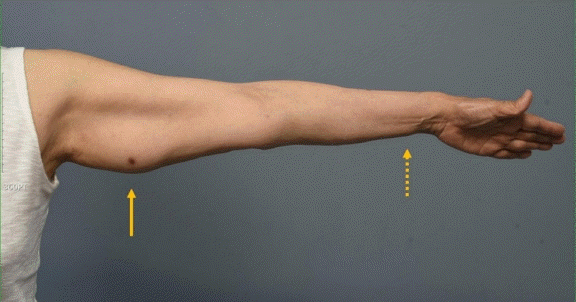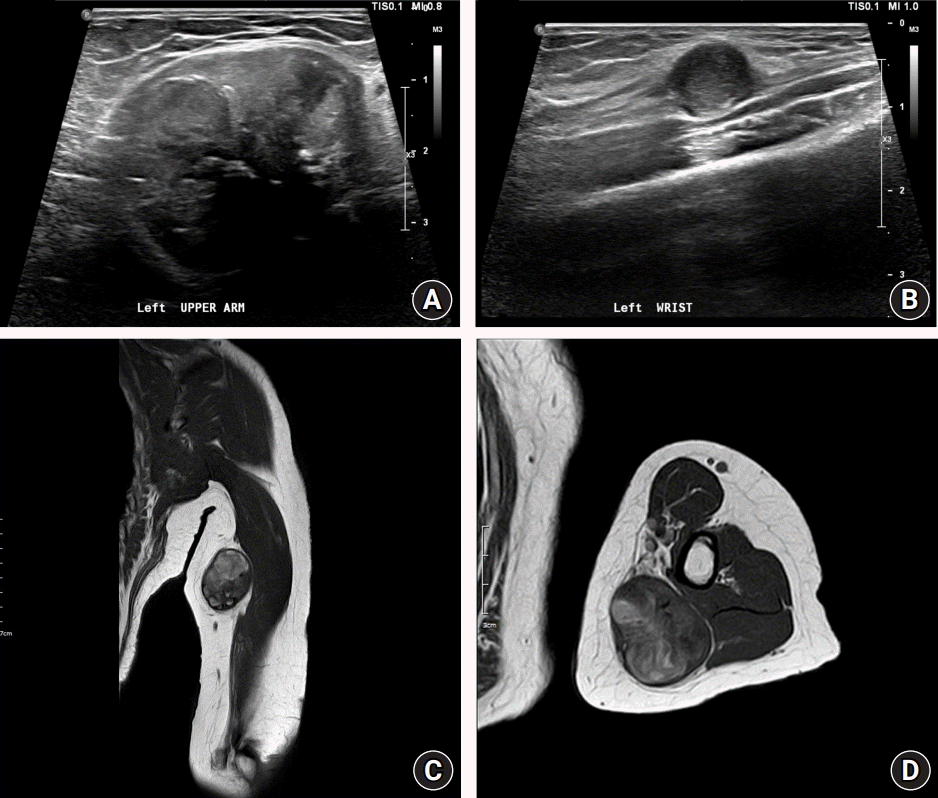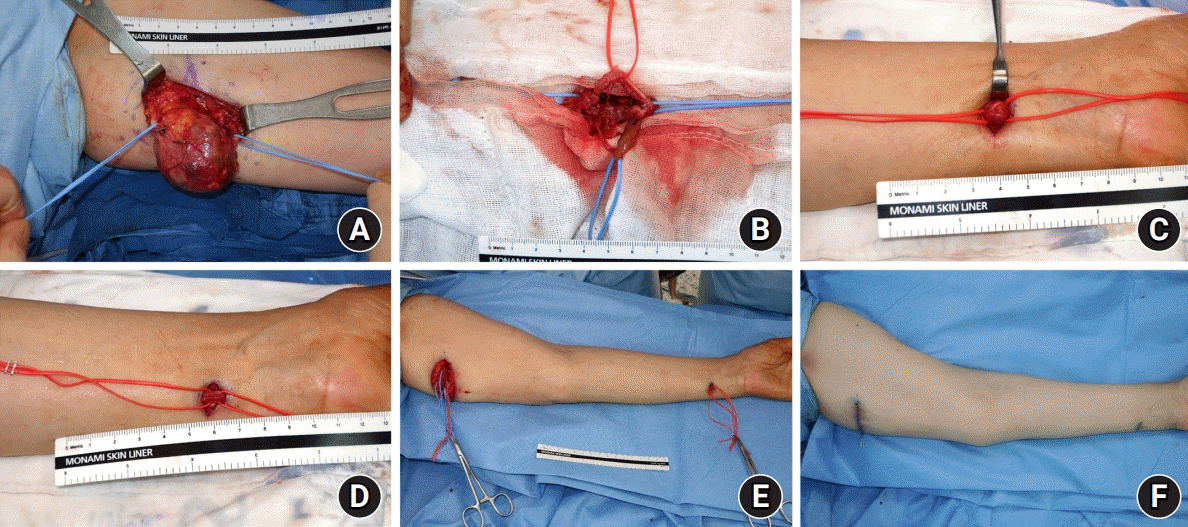Abstract
In rare cases, schwannoma—a benign peripheral nerve tumor—undergoes chronic degenerative changes and progresses to ancient schwannoma. Herein, we report the first case of ulnar nerve-derived multiple ancient schwannomas, which uncommonly developed in the extremities and major nerves. A 76-year-old female patient presented with tingling sensations in her left ring and small fingers. She had a gradually enlarging mass that had developed 40 years ago in the proximal upper arm and a new mass that had grown on the wrist for the past few years. Based on physical examination, ultrasonography, and magnetic resonance imaging, ancient schwannomas of the ulnar nerve were suspected. The older and larger mass in the upper arm was more entangled with nerve fascicles, having necrotic changes. Through meticulous dissection of the nerve fascicles, both masses were successfully enucleated, and pathological examination confirmed ancient schwannoma. As ancient schwannomas grow, they become more entangled with the nerves; thus, early surgical removal is recommended.
Schwannoma is a common solitary encapsulated benign tumor occurring from Schwann cells in the peripheral nerve sheath [1–3]. It rarely undergoes chronic degenerative changes and slowly progresses to ancient schwannoma with hypocellular areas. Compared with schwannomas that frequently occur in the upper extremity (19%) [1], ancient schwannomas do not commonly develop in the extremities. Cases involving the major nerves of the upper extremities are sporadic. Although the overall clinical features of an ancient schwannoma are similar to that of a schwannoma, attention should be paid to the possibility of it being misdiagnosed as a malignant tumor in imaging and pathological examinations. In addition, as the size of the ancient schwannoma increases through degenerative changes over an extended period, the resulting mass effect and entanglement with nerve fascicles may intensify. Herein, we report a case of multiple ancient schwannomas of the ulnar nerve in an older woman.
A 76-year-old female patient presented with tingling sensations in her left ring and small fingers. She had a gradually enlarging mass that developed 40 years ago in the proximal upper arm. Physical examination demonstrated a 4-cm painless firm soft-tissue mass with a negative Tinel’s sign at the posteromedial aspect of left upper arm. She also complained of a 1-cm new mass growing on the left wrist for the past few years which also had a negative Tinel’s sign and no pain or tenderness (Fig. 1).
Based on the physical examination, benign soft-tissue tumors derived from the ulnar nerve were suspected, and imaging tests were performed. Ultrasound and magnetic resonance imaging (MRI) suggested ulnar nerve-derived ancient schwannomas with hyalinization, hemorrhagic cystic segments, and multifocal calcifications (Fig. 2) [4]. Symptomatic schwannoma requires surgical excision, and the ancient schwannoma must be distinguished from a malignant nerve sheath tumor by pathological examination, which requires a more active intervention [5]. As ancient schwannoma is benign and the masses originated from a major nerve in this case, excision was performed according to benign tumors like schwannoma, and no wide excision or frozen biopsy, other than permanent biopsy, was conducted. Since the patient’s tingling sensation was closely related to the onset of the wrist mass, it was possible that the wrist mass, rather than the upper arm mass, was the cause of the symptoms. As there was no obvious sensory abnormality in the dorsal area dominated by the dorsal cutaneous branch of the ulnar nerve before surgery, the symptoms were suspected to be caused by the wrist mass, which could be removed first. However, the diagnosis was incomplete through the preoperative questionnaire and physical examination, and the patient wished to have all the masses removed; therefore, both masses were planned to be excised.
During surgery, the older ancient schwannoma of the upper arm was larger and more entangled with the derived nerve fascicles, showing necrotic change at the center, making removal more difficult. Both masses were successfully enucleated through meticulous dissection (Figs. 3, 4). The pathology department was informed that the masses were suspected to be ancient schwannoma so that more attention was given to them, and pathological examination confirmed the diagnosis of ancient schwannoma. At the outpatient follow-up, the patient’s tingling sensation in the fourth and fifth fingers of the left hand, which was the chief complaint before the operation, disappeared, and there was no pain or tenderness. However, she showed mild ulnar nerve palsy symptoms, and she complained of decreased sensory and motor function in the left ulnar nerve-innervated area compared to the right. The patient is presently undergoing rehabilitation treatment.
The study was approved by the Institutional Review Board of Seoul National University Hospital (No. H-2110-032-1260) and performed in accordance with the principles of the Declaration of Helsinki. Written informed consent was obtained. The patient provided written informed consent for the publication and the use of her images.
Schwannoma, also called neurilemmoma, is the most common benign tumor of peripheral nerves [1,2]. Small schwannomas often have no motor and sensory symptoms; however, pain, tenderness, paralysis of the affected nerve, and Tinel’s sign may be observed in some cases [3]. Schwannoma can be diagnosed relatively accurately through ultrasonography and MRI even when clinically challenging to differentiate. Histologically, schwannoma comprises two areas: Antoni A areas, which are organized, hypercellular, and comprise spindle cells; and Antoni B areas, which are less organized, hypocellular, and contain myxoid tissue [6].
Ancient schwannoma is a type of schwannoma that gradually grows chronically, and histologically, it shows degenerative changes such as hemorrhage, cystic formation, calcification, and perivascular hyalinization [2,4]. Cystic areas of ancient schwannomas may lead to radiologic misdiagnosis as other tumors, such as malignant fibrous histiocytoma, malignant peripheral nerve sheath tumor, liposarcoma, synovial sarcoma, or hemangiopericytoma [6]. Degenerative changes and the resulting decrease in Antoni A area and increase in Antoni B area are the basis for histological and radiological differential diagnosis [4,6]. Nevertheless, the diagnosis of ancient schwannoma is complicated because it is rare, atypical, and requires special antibody staining, such as S-100, for pathological confirmation [5]. Ancient schwannoma can be suspected if the mass suspected of schwannoma is large and a long time has elapsed since its onset. There is no other clinically significant difference between ancient schwannoma and schwannoma. Therefore, ancient schwannoma can be suspected through imaging tests and confirmed through pathological examination.
Ancient schwannoma is usually reported to be located deep in the head and neck, thorax, retroperitoneum, pelvis, and extremities in older patients [4,7,8]. Regarding the upper limb, only two single case reports of ancient schwannoma with solitary involvement of either radial or ulnar nerve have been reported [9,10]. For multiple ancient schwannomas involving a major nerve, only one case involving the medial plantar nerve has been reported. To the best of our knowledge, this report is the first case of multiple ancient schwannomas from the same ulnar nerve.
Ancient schwannoma treatment depends on where it occurs and whether it is causing a symptom or growing rapidly. The primary treatment for symptomatic schwannoma is complete surgical excision, and incomplete resection of giant schwannoma may cause local recurrence [7]. Symptomatic ancient schwannoma also requires surgical excision. Although an ancient schwannoma is more likely to be misdiagnosed as a malignant tumor, the prognosis after surgery is similar to that of a schwannoma. In this case, tumor resection was planned in consideration of gradual growth of the ancient schwannoma, potential neurological deficits, and the patient’s need for surgery. Ancient schwannoma is encapsulated and can be removed with minimal damage to the affected nerve. However, as confirmed in this case, as the ancient schwannoma grows, it becomes more entangled with the nerve; thus, early surgical removal is recommended. A rare case of malignant transformation of benign ancient schwannoma has been reported, where the ancient schwannoma was 4×4×2 cm in size, grossly well-circumscribed, and was considered benign until surgery, making diagnosis difficult [5]. Therefore, increased attention is necessary for the differentiation of ancient schwannoma from other malignancies, including malignant peripheral nerve sheath tumor, which requires more aggressive intervention. For an accurate diagnosis, it is necessary to confirm the possibility of ancient schwannoma through an imaging test before surgery, and to accurately deliver an impression to the pathology department after mass excision.
Ancient schwannoma rarely occurs multiple times in a single major nerve. For suspected ancient schwannoma lesions that have grown in size over a long time after their onset, excision is recommended before further involvement of the nerve fascicles, as nerve involvement and postoperative injury may increase over time.
References
1. Das Gupta TK, Brasfield RD, Strong EW, Hajdu SI. Benign solitary schwannomas (neurilemomas). Cancer. 1969; 24:355–66.

2. Bhattacharyya AK, Perrin R, Guha A. Peripheral nerve tumors: management strategies and molecular insights. J Neurooncol. 2004; 69:335–49.

3. Kehoe NJ, Reid RP, Semple JC. Solitary benign peripheral-nerve tumours. Review of 32 years’ experience. J Bone Joint Surg Br. 1995; 77:497–500.

4. Isobe K, Shimizu T, Akahane T, Kato H. Imaging of ancient schwannoma. AJR Am J Roentgenol. 2004; 183:331–6.

5. Mikami Y, Hidaka T, Akisada T, Takemoto T, Irei I, Manabe T. Malignant peripheral nerve sheath tumor arising in benign ancient schwannoma: a case report with an immunohistochemical study. Pathol Int. 2000; 50:156–61.

6. Lee YS, Kim JO, Park SE. Ancient schwannoma of the thigh mimicking a malignant tumour: a report of two cases, with emphasis on MRI findings. Br J Radiol. 2010; 83:e154–7.

8. Shilpa B. Ancient schwannoma-a rare case. Ethiop J Health Sci. 2012; 22:215–8.
9. Malizos K, Ioannou M, Kontogeorgakos V. Ancient schwannoma involving the median nerve: a case report and review of the literature. Strategies Trauma Limb Reconstr. 2013; 8:63–6.

10. Joseph CM, Cherian M, Mishra MN, Chase A. Ancient schwanomma of the distal ulnar nerve: a rare presentation. J Clin Mol Pathol. 2020; 4:24.
Fig. 1.
Multiple masses presented in the posteromedial aspect of the patient’s left upper arm and wrist. A 4-cm firm, painless mass was palpated on the patient’s left upper arm (arrow). A 0.5-cm firm, painless mass was palpated on the patient’s wrist (dotted arrow).

Fig. 2.
Ultrasound and magnetic resonance T1 imaging. On ultrasound imaging, well-circumscribed heterogeneous echoic masses with internal calcification and internal vascularity originating from the ulnar nerve are observed in the subcutaneous layer of the upper arm (A) and wrist (B). The hyaline degeneration, cystic change, calcification, and hemorrhage observed on a magnetic resonance image of the upper arm mass are typical characteristics of ancient schwannoma (C, D).

Fig. 3.
Multiple ancient schwannomas of the upper arm (A and B) and wrist (C and D) from the ulnar nerve. (A, C) Ancient schwannomas originating from the ulnar nerve are surrounded by nerve fascicles. (B, D) The masses are resected from the upper arm and forearm with minimal nerve damage through meticulous dissection. (E, F) Multiple ancient schwannomas are enucleated from the ulnar nerve of the left arm.

Fig. 4.
Enucleated ancient schwannomas, magnified image, and immunohistochemical staining. The upper arm mass had developed for a longer period than the wrist mass. Hence, it is larger (A) and more entangled with the nerve fascicles (B). (C) Immunohistochemical staining is positive for S-100, a typical feature of schwannoma (×40).





 PDF
PDF Citation
Citation Print
Print



 XML Download
XML Download